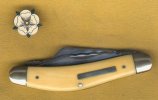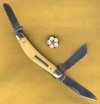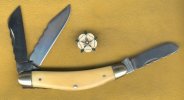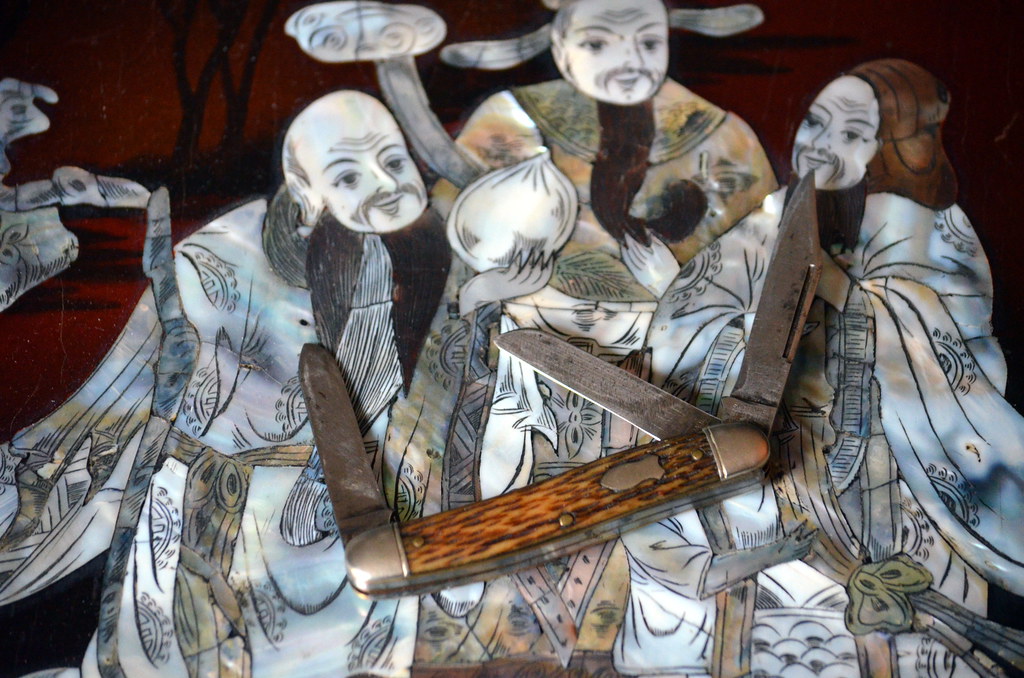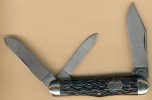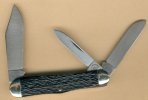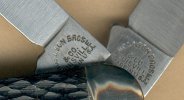-
The BladeForums.com 2024 Traditional Knife is available! Price is $250 ea (shipped within CONUS).
Order here: https://www.bladeforums.com/help/2024-traditional/
You are using an out of date browser. It may not display this or other websites correctly.
You should upgrade or use an alternative browser.
You should upgrade or use an alternative browser.
From Cattle Knife to Stockman!
- Thread starter waynorth
- Start date
Luger1952
Gold Member
- Joined
- Jan 12, 2012
- Messages
- 1,397
Great thread idea Charlie!! Beautiful Stockman/Cattle Knives everyone and great research
Here are some Robeson Pocket Eze Stockman pattern folders. The bottom two are junior Stockman. The middle one doesn’t exactly meet BL’s definition with a secondary opposite pivot end wood carving blade but it is close. These all have sunken joints (a top usual feature of the Pocket Eze line) except the top early Pocket Eze. In fact the top one has bronze bearings on the two front pivot blade tangs. This was a unique characteristic of the Mastercraft Robeson line before the bronze bearings ended with the rare to find Perma Lube line with the bronze bearing moved to the spring tips or ends. Seeing this Pocket Eze with tang bronze bearings is interesting in that maybe this was a first early attempt at this process which became a standard production feature on the Robeson Mastercraft line. I have seen no other Pocket Eze with tang bronze bearings. How this relates to the production time line I do not presently know.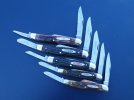
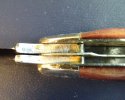

Here are some Robeson Pocket Eze Stockman pattern folders. The bottom two are junior Stockman. The middle one doesn’t exactly meet BL’s definition with a secondary opposite pivot end wood carving blade but it is close. These all have sunken joints (a top usual feature of the Pocket Eze line) except the top early Pocket Eze. In fact the top one has bronze bearings on the two front pivot blade tangs. This was a unique characteristic of the Mastercraft Robeson line before the bronze bearings ended with the rare to find Perma Lube line with the bronze bearing moved to the spring tips or ends. Seeing this Pocket Eze with tang bronze bearings is interesting in that maybe this was a first early attempt at this process which became a standard production feature on the Robeson Mastercraft line. I have seen no other Pocket Eze with tang bronze bearings. How this relates to the production time line I do not presently know.


Luger1952
Gold Member
- Joined
- Jan 12, 2012
- Messages
- 1,397
Thanks Charlie—appreciate your nice comments!! Yes, Robeson made some great folders and were innovative and looking for ways to enhance their folders and their function. The bronze bushing on the tang had some problems with the bushing tending to separate or pull out of its tang notches hence the idea to move the bronze bushing to the spring end with the Perma Lube line. However very few Perma Lube folders were produced (I have one a small Whittler pattern) and cost cutting post war put and end to this innovation. The bronze bearing made blade deployment a smoooooth experience

lambertiana
Gold Member
- Joined
- Jul 7, 2000
- Messages
- 9,731
This catalog page (1886 HSB catalog) is the earliest image that I have of a serpentine stockman. Note that the middle knife is what we now recognize as a standard size 3 7/8"stockman, but is still called a cattle knife.


lambertiana
Gold Member
- Joined
- Jul 7, 2000
- Messages
- 9,731
The bottom knife is a nice hefty Cattle knife. Do they call it that anywhere, Lambertiana??
In this image, from the same 1886 HSB catalog, is an interesting mix. The third knife is what we identify as a cattle knife, and has Cattle Knife etched on the blade. But look at the bottom knife - a three-bladed cokebottle with a Stock Knife blade etch and identified as a cattle knife in the text. Now that is a knife I would like to have in my collection.

- Joined
- Jan 17, 2011
- Messages
- 15,193
I looked an oddly enough..I don't. I'll have to remedy that for you tomorrowI like your Schrade. Do you have a picture with the knife open?
- Joined
- Dec 19, 2006
- Messages
- 8,210
Excellent catalog examples
L
lambertiana
 Luger1952
What didn't that company think of?!? They did ...sunk joints, bushings, bolster locks, famous heat treat for stainless...etc. I've seen a couple examples but I have never used one of the Robesons with the bushings. I wonder if wear to the tang bushing from the steel spring weakened the snap after lots of use. Would be interesting to study. I'm sure the manufacturing cost were prohibitive but I wonder if it would be something worthwhile on high end knives today. The bushings on customs are typically only at the pivot pin, not on the tang.
Luger1952
What didn't that company think of?!? They did ...sunk joints, bushings, bolster locks, famous heat treat for stainless...etc. I've seen a couple examples but I have never used one of the Robesons with the bushings. I wonder if wear to the tang bushing from the steel spring weakened the snap after lots of use. Would be interesting to study. I'm sure the manufacturing cost were prohibitive but I wonder if it would be something worthwhile on high end knives today. The bushings on customs are typically only at the pivot pin, not on the tang.
I'm enjoying the photos, guys !
Still looking forward to seeing a "premier cattle"
I'm enjoying the photos, guys !
Still looking forward to seeing a "premier cattle"
Last edited:
- Joined
- Dec 19, 2006
- Messages
- 8,210
Sowbelly stockman and cattle knives by Ryu




- Joined
- Jan 17, 2011
- Messages
- 15,193
black mamba
Gold Member
- Joined
- Oct 21, 2009
- Messages
- 23,594
Does anyone know when the gunstock stockman first appeared? Here is a nice large example from S&M.

And this is the most unusual cattle knife I have, a Eureka pattern.


And this is the most unusual cattle knife I have, a Eureka pattern.

SVTFreak
Gold Member
- Joined
- Mar 8, 2011
- Messages
- 5,494
Sowbelly stockman and cattle knives by Ryu


Those are incredible. But isn’t the second one a sowbelly whittler? Interesting pattern for sure, and very good looking!
Mr Ryu’s father in law is not well and has impeded his knife making for a time. That’s held mine up, which is ok. Family first.
Thanks.
I have a similar one. Same age, handle, shield and lovely worn bone, but with a punch. Sorry I can't do a picture. Although mine is scarred by a grinder sharpening and the blades are well worn, the walk/talk is great, no rubbing and it takes/holds an excellent edge. It's knife that came out of Southeast Kansas, Newton KS.
waynorth
Dealer / Materials Provider
- Joined
- Nov 19, 2005
- Messages
- 33,349
- Joined
- Dec 19, 2006
- Messages
- 8,210
Those are incredible. But isn’t the second one a sowbelly whittler? Interesting pattern for sure, and very good looking!
Mr Ryu’s father in law is not well and has impeded his knife making for a time. That’s held mine up, which is ok. Family first.
Best wishes for his recovery.
Yes, it is a stockman, a sowbelly, and a whittler.
"Whittler" (and "sowbelly") are silly modern collector terms. Robeson did etch a cattle knife "whittler" but the modern use of the word means something entirely different. At least one brand had a pattern they described as "coping" that is similar to one (of many) patterns typically described as a whittler by present day collectors and manufacturers.
Present day manufacturers have taken the collector term and ran with it. I remember some good discussions with Ken Erickson about the term a while back. Would make fun rereading if I find the old posts.
Last edited:

